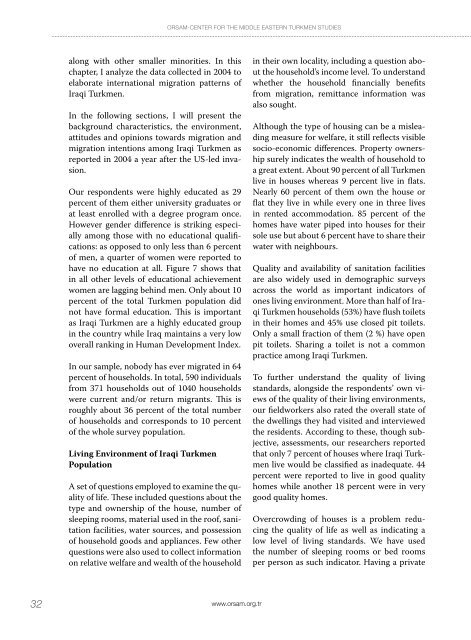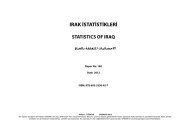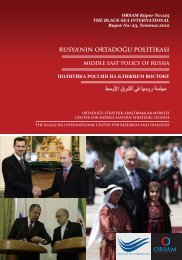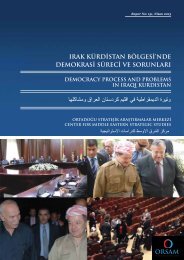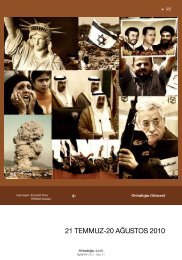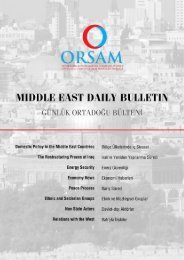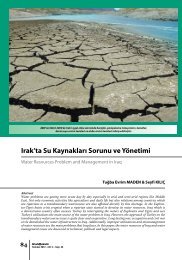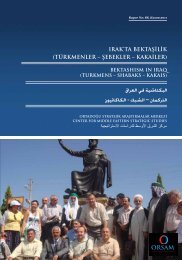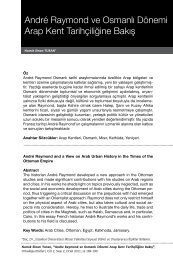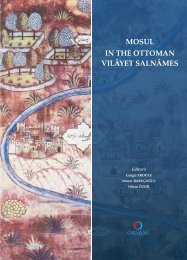turkmen in iraq and their flight - orsam
turkmen in iraq and their flight - orsam
turkmen in iraq and their flight - orsam
You also want an ePaper? Increase the reach of your titles
YUMPU automatically turns print PDFs into web optimized ePapers that Google loves.
ORSAM-CENTER FOR THE MIDDLE EASTERN TURKMEN STUDIES<br />
along with other smaller m<strong>in</strong>orities. In this<br />
chapter, I analyze the data collected <strong>in</strong> 2004 to<br />
elaborate <strong>in</strong>ternational migration patterns of<br />
Iraqi Turkmen.<br />
In the follow<strong>in</strong>g sections, I will present the<br />
background characteristics, the environment,<br />
attitudes <strong>and</strong> op<strong>in</strong>ions towards migration <strong>and</strong><br />
migration <strong>in</strong>tentions among Iraqi Turkmen as<br />
reported <strong>in</strong> 2004 a year after the US-led <strong>in</strong>vasion.<br />
Our respondents were highly educated as 29<br />
percent of them either university graduates or<br />
at least enrolled with a degree program once.<br />
However gender difference is strik<strong>in</strong>g especially<br />
among those with no educational qualifications:<br />
as opposed to only less than 6 percent<br />
of men, a quarter of women were reported to<br />
have no education at all. Figure 7 shows that<br />
<strong>in</strong> all other levels of educational achievement<br />
women are lagg<strong>in</strong>g beh<strong>in</strong>d men. Only about 10<br />
percent of the total Turkmen population did<br />
not have formal education. This is important<br />
as Iraqi Turkmen are a highly educated group<br />
<strong>in</strong> the country while Iraq ma<strong>in</strong>ta<strong>in</strong>s a very low<br />
overall rank<strong>in</strong>g <strong>in</strong> Human Development Index.<br />
In our sample, nobody has ever migrated <strong>in</strong> 64<br />
percent of households. In total, 590 <strong>in</strong>dividuals<br />
from 371 households out of 1040 households<br />
were current <strong>and</strong>/or return migrants. This is<br />
roughly about 36 percent of the total number<br />
of households <strong>and</strong> corresponds to 10 percent<br />
of the whole survey population.<br />
Liv<strong>in</strong>g Environment of Iraqi Turkmen<br />
Population<br />
A set of questions employed to exam<strong>in</strong>e the quality<br />
of life. These <strong>in</strong>cluded questions about the<br />
type <strong>and</strong> ownership of the house, number of<br />
sleep<strong>in</strong>g rooms, material used <strong>in</strong> the roof, sanitation<br />
facilities, water sources, <strong>and</strong> possession<br />
of household goods <strong>and</strong> appliances. Few other<br />
questions were also used to collect <strong>in</strong>formation<br />
on relative welfare <strong>and</strong> wealth of the household<br />
<strong>in</strong> <strong>their</strong> own locality, <strong>in</strong>clud<strong>in</strong>g a question about<br />
the household’s <strong>in</strong>come level. To underst<strong>and</strong><br />
whether the household f<strong>in</strong>ancially benefits<br />
from migration, remittance <strong>in</strong>formation was<br />
also sought.<br />
Although the type of hous<strong>in</strong>g can be a mislead<strong>in</strong>g<br />
measure for welfare, it still reflects visible<br />
socio-economic differences. Property ownership<br />
surely <strong>in</strong>dicates the wealth of household to<br />
a great extent. About 90 percent of all Turkmen<br />
live <strong>in</strong> houses whereas 9 percent live <strong>in</strong> flats.<br />
Nearly 60 percent of them own the house or<br />
flat they live <strong>in</strong> while every one <strong>in</strong> three lives<br />
<strong>in</strong> rented accommodation. 85 percent of the<br />
homes have water piped <strong>in</strong>to houses for <strong>their</strong><br />
sole use but about 6 percent have to share <strong>their</strong><br />
water with neighbours.<br />
Quality <strong>and</strong> availability of sanitation facilities<br />
are also widely used <strong>in</strong> demographic surveys<br />
across the world as important <strong>in</strong>dicators of<br />
ones liv<strong>in</strong>g environment. More than half of Iraqi<br />
Turkmen households (53%) have flush toilets<br />
<strong>in</strong> <strong>their</strong> homes <strong>and</strong> 45% use closed pit toilets.<br />
Only a small fraction of them (2 %) have open<br />
pit toilets. Shar<strong>in</strong>g a toilet is not a common<br />
practice among Iraqi Turkmen.<br />
To further underst<strong>and</strong> the quality of liv<strong>in</strong>g<br />
st<strong>and</strong>ards, alongside the respondents’ own views<br />
of the quality of <strong>their</strong> liv<strong>in</strong>g environments,<br />
our fieldworkers also rated the overall state of<br />
the dwell<strong>in</strong>gs they had visited <strong>and</strong> <strong>in</strong>terviewed<br />
the residents. Accord<strong>in</strong>g to these, though subjective,<br />
assessments, our researchers reported<br />
that only 7 percent of houses where Iraqi Turkmen<br />
live would be classified as <strong>in</strong>adequate. 44<br />
percent were reported to live <strong>in</strong> good quality<br />
homes while another 18 percent were <strong>in</strong> very<br />
good quality homes.<br />
Overcrowd<strong>in</strong>g of houses is a problem reduc<strong>in</strong>g<br />
the quality of life as well as <strong>in</strong>dicat<strong>in</strong>g a<br />
low level of liv<strong>in</strong>g st<strong>and</strong>ards. We have used<br />
the number of sleep<strong>in</strong>g rooms or bed rooms<br />
per person as such <strong>in</strong>dicator. Hav<strong>in</strong>g a private<br />
32<br />
www.<strong>orsam</strong>.org.tr


